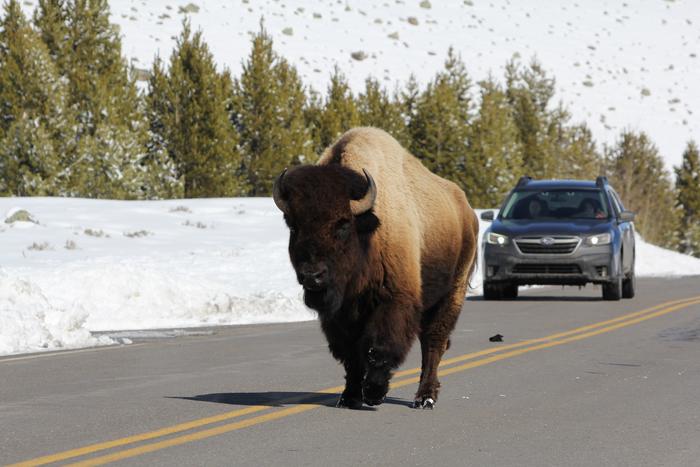When did you last go anywhere without your cell phone? From maps and weather apps to social media platforms, we give consent for our phones to trace our footsteps and behavior. These curated mobility data are often used for personalized advertisements. In a commentary, published April 26 in the journal Cell Reports Sustainability, scientists argue mobility data can offer so much more—it is key to understanding human-wildlife interactions for guiding policy decisions on sustainability-related issues and should be free and accessible for research.

Credit: Matthias Loretto
When did you last go anywhere without your cell phone? From maps and weather apps to social media platforms, we give consent for our phones to trace our footsteps and behavior. These curated mobility data are often used for personalized advertisements. In a commentary, published April 26 in the journal Cell Reports Sustainability, scientists argue mobility data can offer so much more—it is key to understanding human-wildlife interactions for guiding policy decisions on sustainability-related issues and should be free and accessible for research.
As the COVID-19 pandemic confined humans indoors and hushed bustling cities, reports of wildlife wandering the streets flooded the internet. To ecologists and sustainability researchers, this was a unique opportunity to understand human-wildlife interactions, afforded by the most tragic of circumstances. Scientists, including some of the authors of the commentary, quickly joined hands to form the COVID-19 Bio-Logging Initiative.
“Our global consortium has been investigating wildlife responses to sudden reductions in human mobility during pandemic lockdowns, using tracking data from animal-attached devices,” says senior author Christian Rutz, of University of St Andrews, UK, who is the chair of the COVID-19 Bio-Logging Initiative. “Such analyses of human-wildlife interactions would benefit tremendously from improved access to human-mobility data.”
“What we very quickly realized is that we had a wealth of data on what animals were doing, but gaining access to data on what humans were doing was a major challenge,” says first author Ruth Oliver of the University of California, Santa Barbara. “Generally, human-mobility data are held by private companies and sold for corporate interests. There are financial and logistical barriers for researchers to access the data to understand sustainability challenges.”
To address this issue, the authors propose that governments and international organizations work together with companies on finding ways to make human-mobility data freely available for research. Drawing on lessons learned from the precedent of government-facilitated access to satellite remote sensing data for public good, the researchers believe human-mobility data hold similar potential, if access barriers were addressed.
Unlike human-mobility data for commercial purposes, which comprise detailed time-stamped movement trajectories of individual users, potentially posing privacy concerns when shared, what the researchers call for is much simpler. The researchers envision aggregated datasets, stripped of personal identifiers, counting the number of devices in an area over a defined time period. About three out of every four people aged 10 or older—roughly 5.9 billion individuals globally—own a cellular phone. This wealth of data can help address how the health of humans, animals, and ecosystems are connected. For example, analyses could help pinpoint hotspots where wildlife and humans interact frequently, informing zoonotic disease prevention and invasive species management.
“Because the aggregated datasets we’re advocating for are very different from what’s needed for commercial applications, making them accessible to researchers wouldn’t harm the market for more detailed data,” says Oliver.
In fact, Oliver and her colleagues say that making human-mobility data available to researchers can also benefit private companies. Sharing aggregated data may generate further demand for bespoke, detailed data products and grow the global user base. With movements towards corporate digital responsibility, sharing data for conservation and sustainability research can also be a way to mitigate impact and contribute to societal good.
“Our vision is to have this movement be a community-driven, collaborative effort. We want to understand the companies’ concerns and collaborate on finding win-win solutions. Because privacy policies around human mobility-data vary around the world, government bodies’ facilitation will be crucial,” says Oliver. “More broadly, we feel it’s crucial to empower individuals to think about how they want their data used.”
###
This work was supported by the Gordon and Betty Moore Foundation, the National Geographic Society, the Bren School of Environmental Science & Management, NASA FINESST, the Yale Institute for Biospheric Studies, the National Biodiversity Future Center via the PNRR funds of the Italian Ministry of University and Research, and the Natural Sciences and Engineering Research Council of Canada.
Cell Reports Sustainability, Oliver et al. “Access to human-mobility data is essential for building a sustainable future”
Cell Reports Sustainability (@CellRepSustain), published by Cell Press, is a monthly gold open access journal that publishes high-quality research and discussion that contribute to understanding and responding to environmental, social-ecological, technological, and energy- and health-related challenges. Visit https://www.cell.com/cell-reports-sustainability/home. To receive Cell Press media alerts, contact press@cell.com.
Journal
Cell Reports Sustainability
Method of Research
Commentary/editorial
Subject of Research
Not applicable
Article Title
Access to human mobility data is essential for building a sustainable future
Article Publication Date
26-Apr-2024



